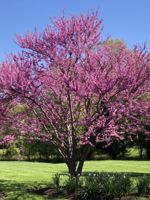Mon-Fri 9am - 5pm Mountain time
Eastern Redbud vs Blue Flax
Linum lewisii
Cercis canadensis
NOT AVAILABLE THIS SEASON - MIGHT RETURN
Blue Flax is a native perennial wildflower known for its blue to violet flowers. Each flower lasts just a single day, but new blooms appear continuously, providing weeks of colour. This extended flowering period provides a reliable display from late spring into summer and attracts a variety of pollinators.
They can self-seed readily, so removing spent blooms helps manage their spread. Birds feed on the seeds, and when cooked, they are edible and are described as having a mild, nutty flavour. The plant grows in loose clumps with slender stems and fine foliage. Young plants are leafy, but as they mature, most leaves are shed.
Blue Flax grows well in a wide range of soils, including poor or sandy conditions, and is drought-tolerant once established. The deep root system helps to stabilize soil and prevent erosion. They are well-suited for pollinator gardens, restoration, naturalization, and xeriscaping projects.
The Eastern Redbud is known for the pea-like pink buds that emerge in clusters on the bark, embellishing the tree in stunning flowers. They have a longer bloom time, sometimes for two to three weeks before the heart-shaped leaves emerge for the summer. Inedible pods emerge that turn brown in the summer, this tree is a part of the bean family.
Native to the Eastern North America. The Eastern Redbud can tolerate acidic and alkaline soil. Plant this as a beautiful understory species or shaded residential yard or garden. The bright pop of color will make an attractive ornamental tree.
Blue Flax Quick Facts
Eastern Redbud Quick Facts
Toxicity: toxic to some animals, raw seed toxic

